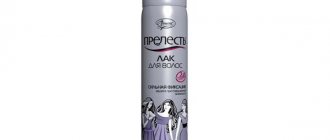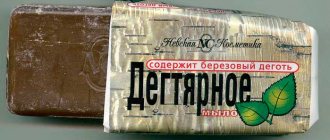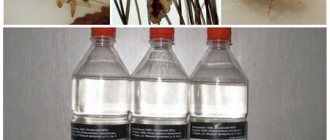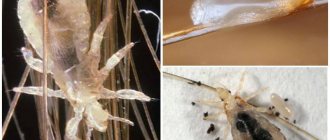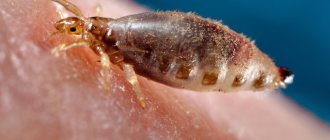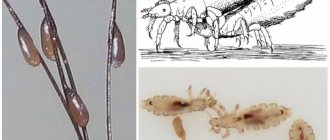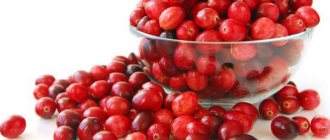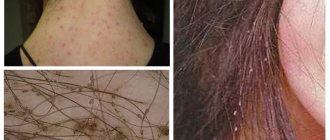Quick facts about lice:
- • Parasites cannot fly or jump; they crawl from head to head, clinging to hair using hooks located at the ends of their legs.
- • Adults lay about 5 eggs (nits), which they attach to the hair with a thick sticky substance.
- • Young lice (nymphs) hatch from the nits after 7-10 days.
- • Lice cannot survive without a host for more than 48 hours.
- • Itching with pediculosis only in 14-36% of cases
In recent years, pharmaceutical anti-pediculosis drugs have become less effective. This is because head lice have developed resistance (resistance) to the insecticides they contain. This is the main reason why many people look for unusual lice treatments, such as hair dye.
The procedure for getting rid of head lice
You can remove lice with hair dye by following the instructions:
- distribute the hair into strands, carefully process each of them;
- put on a plastic bag or a special cap;
- wrap a towel on top;
- leave to act for 30-45 minutes;
- wash off the paint with warm water;
- dilute 200 ml of the bite in 500 ml of water, rinse your hair.
The towel is necessary to create a high temperature on the head. In such conditions, peroxide acts faster, and insects have no chance of survival. Vinegar makes combing easier and helps separate nits from hair. Lightly dry your hair with a hairdryer and begin the combing procedure.
Do lice live on colored hair?
Many women are convinced that regular dyeing helps get rid of lice. But practice shows that parasites feel equally good on clean or dirty, curly or straight, natural or dyed hair.
The chemicals contained in certain types of hair dyes do have a negative effect on lice, but this requires direct exposure. If the infection occurs after dyeing, then the parasites will live and multiply in the same way as on natural hair. Lice feed on blood. The chemicals contained in paints do not penetrate into the human bloodstream, otherwise we would experience unpleasant side effects after painting. Thus, changing hair color has no effect on lice.
How to properly dye your hair to remove lice
The procedure for “therapeutic” (let’s call it that) coloring is almost no different from the standard one. But it is important to take into account all the nuances, because it is necessary to achieve two results at once: get rid of lice and nits and get a uniform color.
- Wear gloves and, if necessary, a gauze mask. If another person is doing the dyeing, he should protect his head with a plastic cap so that the parasites do not jump onto him.
- Comb your hair thoroughly to get rid of the largest specimens.
- Make a parting that is worn most often. This is where painting will begin.
- Apply the freshly prepared paint to your parting with a brush.
- Using a narrow handle of a comb or brush, separate a small strand of hair, highlighting another parting. Paint it over.
- Repeat the previous step until all roots are thoroughly painted.
- Spread the remaining paint along the length. Yes, this may affect the quality of the resulting shade, but the priority is still getting rid of lice and nits, so it is important to work on the root zone of the hair first. Just in case, you can use more tubes of paint than originally intended.
- After dyeing, put a plastic cap on your head and a scarf on top.
- After the required time (as specified in the instructions for the paint), rinse with warm water using a special product included with the package.
To be sure, you can additionally rinse your hair with a solution of 200 ml of vinegar (9%) and 500 ml of water. This folk remedy was used in villages, especially during the war years, when children, often left to their own devices, “brought” lice home.
Attention! The hair coloring procedure to get rid of lice should be carried out only after examination by a trichologist. The doctor should make sure that damage (biting, scratching) to the scalp is minor. Otherwise, the paint will cause severe irritation.
Does hair dye kill lice?
Many modern paints cannot be called effective against lice. They are made from plant extracts without the addition of toxic substances. To kill parasites, you must choose paint that contains powerful chemicals. They usually contain two components: ammonia or hydrogen peroxide. It was previously thought that both of these ingredients could kill lice. But that's not true. In recent years, parasites have become completely immune to hydrogen peroxide.
Ammonia paint has a certain anti-pediculosis activity. Ammonia is a caustic, alkaline substance that can kill lice with prolonged exposure. But ammonia is not effective against nits, which are protected by a dense shell. Therefore, if you decide to use hair dye against lice, you need
- 1. Be sure to buy paint that contains ammonia.
- 2. Leave the dye on your hair for at least 40 minutes.
- 3. After the coloring procedure, comb your hair thoroughly with a fine-tooth comb.
Since even ammonia paint is not effective against nits, the staining procedure will have to be repeated after 7-10 days.
What paint is suitable for removing lice and nits?
Not every dye is suitable for fighting hair parasites. It must meet at least one important condition - contain hydrogen peroxide. This is the strongest oxidizing agent, which has a detrimental effect on lice and their eggs. Its active substances are capable of destroying the chitinous shell of the parasite and the adhesive substance with which nits adhere to the hair. Therefore, even if after a control wash of your hair all the dead parasites are not washed off with water, it will be easier to comb them out with a fine-toothed comb.
It is easiest for blondes and blondes to remove nits and lice in this way, because it is easier for them to choose the dye. After all, hydrogen peroxide lightens hair, and if a brunette uses this product, his hair may become lighter. But the lightening will occur unevenly, and the strands will appear as if they are burnt out. Therefore, it is better to contact a specialist who will help you choose the paint and use it correctly. But, of course, you will have to look for a master who will be ready to paint a person with lice.
Hair dye: pros and cons (contraindications) of this method
Anti-lice hair dye has the only advantage - it is the ability to combine the dyeing procedure with anti-lice treatment. However, one should take into account the fact that the effectiveness of paint against parasites directly depends on the amount of ammonia it contains. And the more ammonia in the dye, the higher the risk of negative effects on the hair and scalp.
Dermatologists do not recommend using hair dye to treat head lice in children. During childhood, hair is much thinner and more vulnerable to damage from chemicals contained in coloring products. Children are also more prone to allergic reactions, the consequences of which can be very severe.
Additional disadvantages of this method of treating head lice include:
- • Repeated dyeing leads to weakening of hair
- • Hair dye does not kill nits
- • Hair dye is often more expensive than pharmacy anti-lice medications
- • Frequent dyeing significantly increases the risk of an allergic reaction.
In addition, coloring can complicate the process of getting rid of lice. Insects and nits become the same color as your hair, making them almost undetectable.
Instructions for dyeing hair at home
Dyeing your hair with dye that kills lice requires strict adherence to the instructions . First you need to wash and dry your hair, and only then apply the composition to your hair and roots. Before this, the strands should be thoroughly combed to be able to evenly distribute the mixture.
- Determine the area where parasites live. Divide your hair into small sections, inspect the side areas behind the ears and the area near the neck.
- Make a solution of grape vinegar and sea salt and mix with paint to achieve the best effect. To make this solution, simply mix about 10 drops of vinegar in one cup of water along with 1 tbsp. l. sea salt. Shake the mixture well and apply to hair using a spray bottle.
- Use a comb to remove nits and eggs first. Start by combing each section of hair through dry, damp, or half-wet hair for 10 minutes.
- Apply your desired hair color and follow the instructions on the package.. You will need to first mix the hair dye and bleach agent well and then apply it to your hair with a special brush or applicator. If you are using highly concentrated ammonia hair dye, do not leave it on for more than an hour as you will damage your hair.
- Rinse your hair thoroughly with shampoo. This will reinforce the previous steps and catch any remaining lice and nits. Make sure you leave the shampoo and conditioner in your hair for at least a couple of minutes. Rinse as usual.
The above steps should be enough to kill most (not all) necks and their eggs.
What safety methods should be used with this method of getting rid of lice?
Despite the fact that many of us consider the dyeing process a routine procedure, we should not forget about the safety rules:
- 1. Before the procedure, check the paint for an allergic reaction. To do this, apply a small amount of paint to the skin of your hand (elbow area or wrist) and leave for 12 hours. If during this time no signs of allergy appear - itching, swelling, redness - the paint can be used.
- 2. Carefully examine your scalp before the procedure. Do not use hair dye if there are wounds on the scalp that appeared after combing lice bites. When chemicals get into these wounds, they can cause burns or allergies.
- 3. Use disposable gloves to protect your hands
- 4. Be careful not to get the coloring agent in your eyes or mouth.
- 5. Avoid inhaling paint fumes. Carry out the procedure in a well-ventilated area.
As mentioned above, ammonia paints should not be used to treat lice in children.
Alternative Treatments
All methods of getting rid of lice can be divided into three main groups:
- • Mechanical removal. This method involves removing live parasites and nits manually. To do this, take a fine-toothed comb and comb your hair thoroughly. The advantage of this method is that it is absolutely safe. Disadvantage: you will have to spend a lot of time and effort to completely get rid of lice.
- • Home remedies. There are a huge number of lice recipes that can be used at home. These include: essential oils, kerosene, mayonnaise, olive oil, vinegar and many others. The main disadvantage of these methods is low efficiency. In most cases, treatment is delayed and ultimately the insects have to be removed mechanically. The advantages include financial savings - most ingredients can be found in every kitchen
- • Pharmacy drugs. Today you can find a wide range of pediculicides in pharmacies. These can be shampoos, emulsions and sprays. The undoubted advantage of using pharmaceutical products is that they are all pre-tested and are considered relatively safe. The downside is that lice have become resistant to insecticides, so many drugs are simply ineffective.
Choosing a dye
Hair dyes only kill lice and nits if they contain ammonia and hydrogen peroxide or at least one of these components. These are quite aggressive chemical agents that act as oxidizing agents in the compositions.
The substances enter into a chemical reaction with biological membranes; they can destroy not only the hair cuticle, but also the louse shell. Parasites begin to die immediately after applying the paint.
As for the harmless, gentle compounds that manufacturers now offer, they will not suit us. Only permanent, persistent products can come to the rescue, as they have a rather aggressive composition.
How to get rid of lice without unnecessary problems?
The main problem in the treatment of head lice is that lice quickly adapt to toxic substances (insecticides) and stop responding to them. "Paranit" has a fundamentally new mechanism of action. They contain dimethicone and mineral oil.
Dimethicone is a silicone-based polymer that is found in many cosmetics. It helps moisturize the skin, creating a thin barrier. So why did this substance, safe and beneficial for humans, become destructive for parasites?
The answer lies in the life activity of lice. They have seven openings (spiracles) on each side of the body that merge into the trachea. The tracheae branch and form a thin network that supplies insects with oxygen. Through the same network they remove excess fluid after drinking blood. Due to the high surface tension of water, it does not penetrate the microscopic spiracles. And dimethicone copes with this task. It tightly clogs the respiratory system of lice, depriving them of oxygen and disrupting their water balance. This substance also affects nits in the same way - without the ability to breathe, they die.
Since dimethicone and mineral oil are non-toxic substances, Paranit anti-pediculosis products can be used to treat children from 3 years of age, and Paranit Sensitive lotion is suitable for children from 1 year of age and pregnant women. In addition, the processing can be repeated many times. Paranit products are available in various forms, and therefore are suitable for treating all family members. This is a simple and effective way to deal with an unpleasant problem without risk to health.

